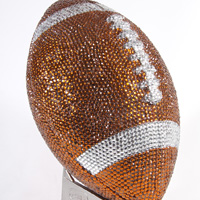 A couple years ago, I spent twenty-something hours applying thousands of 4 mm rhinestones to a football. At the time it just seemed like the right thing to do. But as I worked on it, I began to see the football as a visual metaphor for the simultaneous combination of masculinity and femininity – a central crux of my work. Since then, I’ve continued to fixate on this notion of football as a personal metaphor for extreme masculinity. That fascination lead to my current project in which I am adorning a football uniform with sequins, beaded fringe and rhinestones.
A couple years ago, I spent twenty-something hours applying thousands of 4 mm rhinestones to a football. At the time it just seemed like the right thing to do. But as I worked on it, I began to see the football as a visual metaphor for the simultaneous combination of masculinity and femininity – a central crux of my work. Since then, I’ve continued to fixate on this notion of football as a personal metaphor for extreme masculinity. That fascination lead to my current project in which I am adorning a football uniform with sequins, beaded fringe and rhinestones.
Recently, as I was working away, I began hearing the echo of a question I often hear in response to my work, “What are you making it for?” Beyond the obvious answers (at least to me) of “I’m an artist. It’s what I do,” or “It’s what I’m meant to do and it makes me happy,” I found myself diligently asking “Why am I doing this? Why football?” Without a moments pause, it was as if the universe opened my mind’s eye and began showing me a slideshow of teachers, coaches, high school classmates and frat boys from college, all of whom in some way or another directly made it known through critical glances, enlarged body language, insult and even bullying, that my effeminacy and sexuality were not acceptable. Undoubtedly, football represented fear.
I learned early on that to be different in this way meant that I wasn’t always safe, especially in rural and Central Kansas where I grew up and went to school. Over time, it invoked a hyper-vigilance toward people and situations – a quick eye that could assess my level of safety. It became a survival mechanism of sorts that I use to this day, so not all was bad.
 Snapped back to the present, I realized that the presence of football in my art-making is an act of alchemy – a taking of trash and turning it into gold. The football (and sparkle) is my way of digesting that fear, transforming it into a golden thread and weaving into the current evolution of life. Now, I’m also wise enough to understand that the lesson isn’t complete. The costume is still in process, so there’s plenty more about fear, football and transformation to be learned during the construction. And for all of that, I feel fortunate.
Snapped back to the present, I realized that the presence of football in my art-making is an act of alchemy – a taking of trash and turning it into gold. The football (and sparkle) is my way of digesting that fear, transforming it into a golden thread and weaving into the current evolution of life. Now, I’m also wise enough to understand that the lesson isn’t complete. The costume is still in process, so there’s plenty more about fear, football and transformation to be learned during the construction. And for all of that, I feel fortunate.

![Detail of "Madame X [After John Singer Sargent]"](https://i1.wp.com/www.jkinser.com/wp-content/uploads/2013/05/MdmX-300sqr.jpg?resize=300%2C299)


